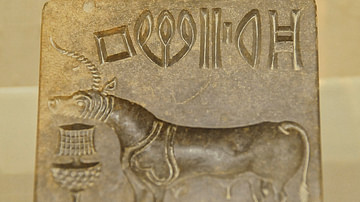
One of the stranger ancient scripts one might come across, Ogham is also known as the 'Celtic Tree Alphabet'. Estimated to have been used from the fourth to the tenth century CE, it is believed to have been possibly named after the Irish god Ogma but this is debated widely. Ogham actually refers to the characters themselves, the script as a whole is more appropriately named Beith-luis-nin after the order of alphabet letters BLFSN.
Description
The script originally contained 20 letters grouped into four groups of five. Five more letters were later added creating a fifth group. Each of these groups was named after its first letter. There are some four to five hundred surviving ogham inscriptions throughout Britain and Ireland with the largest number appearing in Pembrokeshire. The rest of the inscriptions were located around south-eastern Ireland, Scotland, Orkney, the Isle of Man, and around the border of Devon and Cornwall. Ogham was used to write in Archaic Irish, Old Welsh, and Latin mostly on wood and stone, and it is based on a high medieval Briatharogam tradition of ascribing the name of trees to individual characters. The inscriptions containing Ogham are almost exclusively made up of personal names and marks of land ownership.
Origin Theories
There are four popular theories discussing the origin of Ogham. The differing theories are unsurprising considering that the script has similarities to ciphers in Germanic runes, Latin, elder futhark, and the Greek alphabet.
The first theory is based on the work of scholars such as Carney and MacNeill who suggest that Ogham was first created as a cryptic alphabet designed by the Irish. They assert that the Irish designed it in response to political, military, and/or religious reasons so that those with knowledge of just Latin could not read it.
The second theory is held by McManus who argues that Ogham was invented by the first Christians in early Ireland in a quest for uniqueness. The argument maintains that the sounds of the primitive Irish language were too difficult to transcribe into Latin.
The third theory states that the Ogham script from invented in West Wales in the 4th century CE to intertwine the Latin alphabet with the Irish language in response to the intermarriage between the Romans and the Romanized Britons. This would account for the fact that some of the Ogham inscriptions are bilingual; spelling out Irish and Brythonic-Latin.
The fourth theory is supported by MacAlister and used to be popular before other theories began to overtake it. It states that Ogham was invented in Cisalpine Gaul around 600 BCE by Gaulish Druids who created it as a hand signal and oral language. MacAlister suggests that it was transmitted orally until it was finally put into writing in early Christian Ireland. He argues that the lines incorporated into Ogham represent the hand by being based on four groups of five letters with a sequence of strokes from one to five. However, there is no evidence for MacAlister's theory that Ogham's language and system originated in Gaul.
Mythical theories for the origin of Ogham also appear in texts from the eleventh to fifteenth centuries. The 11th-century Lebor Gabala Erenn tells that Ogham was invented soon after the fall of the tower of Babel, as does the 15th-century Auraicept na n-eces text. The Book of Ballymote also includes 92 recorded secret modes of writing Ogham written in 1390-91.






